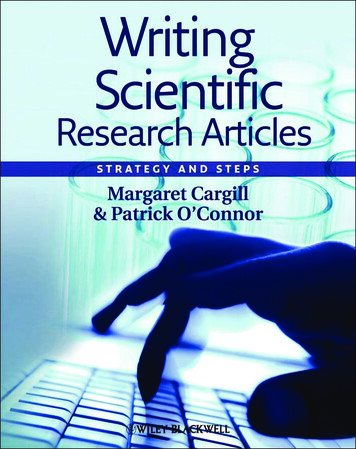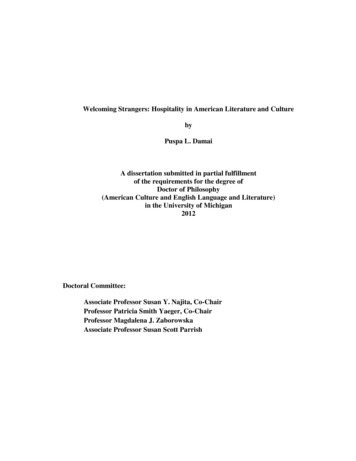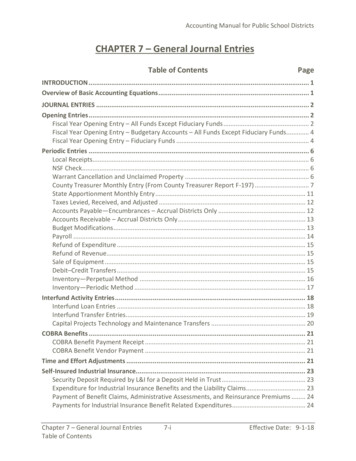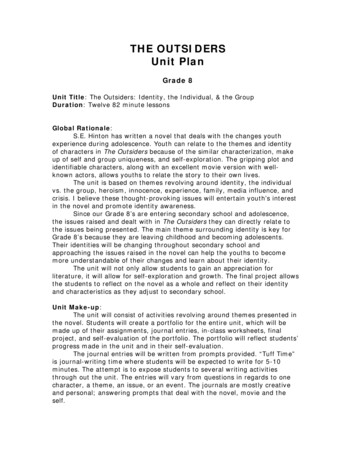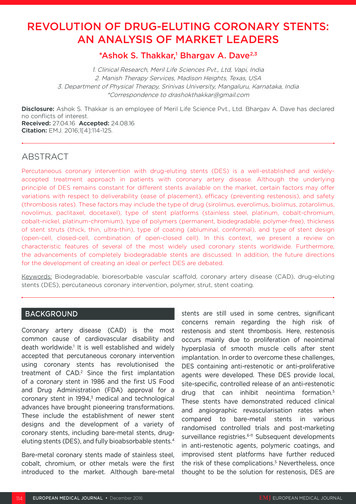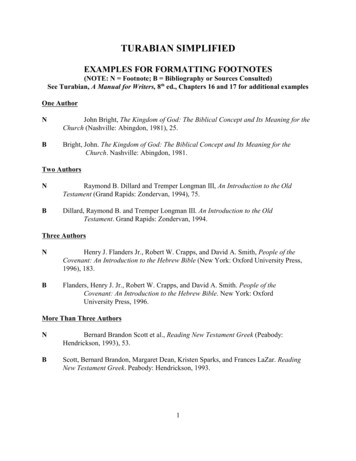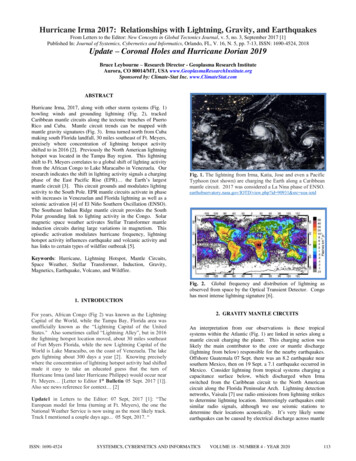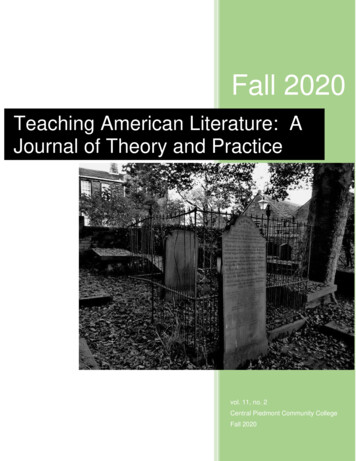
Transcription
Fall 2020Teaching American Literature: AJournal of Theory and Practicevol. 11, no. 2Central Piedmont Community CollegeFall 2020
Teaching American Literature: A Journal of Theory and PracticeFall 2020 (11:2) Special Issue, Teaching Horror in theAmerican Literature ClassroomEditor:Patricia Kennedy Bostian, Central Piedmont Community CollegeGuest Editor:Chris Brawley, Central Piedmont Community CollegeEditorial Board Members:Catherine Waitinas, California State Polytechnic UniversityRobert T. Tally, Jr., Texas State UniversityEarl Yarington, Prince George's Community CollegeMartha Sledge, Marymount Manhattan CollegeISSN: 2150-3974Cover Image: Thomas’s Pics, “The Fall of the House of Usher,” October 12, 2012, This fileis licensed under the Creative Commons Attribution 2.0 Generic license.i
Teaching American Literature: A Journal of Theory and PracticeFall 2020 (11:2) Special Issue, Teaching Horror in theAmerican Literature ClassroomTable of ContentsIntroduction .iiJosé Antonio Arellano, Screwed in 2020: the Psychology of Horror and Class Immobilityin Adaptations of Henry James’s The Turn of the Screw. 1Laura L. Beadling, Weirding Women’s Writing: Karen Russell’s “St. Lucy’s Home forGirls Raised by Wolves” as a Defamiliarizing Lens . 14Russell Brickey, Weird Language and Weirder Places: Reading and Teaching the Weirdin Poetry . 23Alissa Burger, Visualizing Poe: Graphic Novels, Extraordinary Tales, and The Simpsons. 32Patricia A. West, Presenting Mystery, Mayhem, and Madness: Getting Students to Readand Respond to Crazy American Literary Texts . 46IntroductionMany years ago, Chris Brawley and I bonded over horror fiction. I hadn’t read any H.P. Lovecraft at the time and Chris couldn’t stop talking about him. I began with The Shadowover Innsmouth and spent an entire summer reading just about everything Lovecraft wrote.After that summer, every conversation Chris and I had began with “what have you beenreading good lately?” The subtext was, “what have you been reading that is strange, weird,spooky, and other?”Although we both agree that the stories of M. R. James and Algernon Blackwood aresome of our favorites, our tastes in the weird and supernatural mostly go in differentdirections. I am an unrepentant reader of 19th-century British and American ghost stories andI have been making my way through all nineteen volumes of The Wimbourne Book ofVictorian Ghost Stories. Stories of the supernatural by American authors such as EdithWharton and Mary Wilkins Freeman are among my favorites. Chris, on the other hand, hasmore of a taste for the American writers Thomas Ligotti and Edgar Allan Poe (he greatlyappreciated the Poe mug I brought him back from the Poe Museum in Richmond, Virginia).His favorite Jeff VanderMeer collection is The Weird: A Compendium of Strange and DarkStories, whereas mine is The Big Book of Modern Fantasy.But two works we both agree are indisputably important to the genres of horror andthe Weird are Mary Shelley’s Frankenstein and Bram Stoker’s Dracula. Chris was able toii
Teaching American Literature: A Journal of Theory and PracticeFall 2020 (11:2) Special Issue, Teaching Horror in theAmerican Literature Classroomsecure Leslie Klinger, the editor of The New Annotated Frankenstein, for Sensoria, CentralPiedmont Community College’s art festival, in 2018. The auditorium was packed and studentsloved his talk. Both Frankenstein and Dracula are taught in British Literature classrooms togreat critical acclaim, but there is not similar space granted in the American Literatureclassroom for the teaching of American horror/supernatural and the Weird. Why is that?I think I have part of the answer. When Chris was working on his PhD at Florida StateUniversity, he struggled with getting his readers on board with his topic of the numinous inthe fantasy fiction of C. S. Lewis and J. R. R Tolkien. Why? Fantasy fiction is just not valuedas much as “classic” literary works in the literature classroom. I believe the same holds truefor the Weird and the supernatural. This is fringe material with only the most “literary” of works,such as Poe or Gilman’s “The Yellow Wall-Paper” included in most anthologies. Yet studentslove reading “creepy” and “weird s@#%.” They will never complain about being assigned aPoe short story, for example, even though Poe really is difficult reading.In this issue, we present articles by scholars who have found ways to integratesupernatural and Weird fiction, and even poetry, film, and graphic novels, into their syllabi.They explain how they do so, and more importantly, why they do so. What is the point? Whatdo students get out of reading the Weird, other than entertainment?José Antonio Arellano answers that question in “Screwed in 2020: The Psychology ofHorror and Class Immobility in Adaptations of Henry James’s The Turn of the Screw” byoffering an approach to teaching two adaptations of Henry James’s novella The Turn of theScrew that appeared in 2020, The Haunting of Bly Manor and The Turning, through the lensof the psychology of horror. We know that by providing students with interpretive lensesthrough which to read literature, we help them become more critical thinkers in all areas, notjust in literature. By examining contemporary adaptations of historical works, we also helpstudents see the value of “literature,” which like art, has long term value, rather than fulfillingan immediate disposable entertainment itch.Alisa Burger sees value in adaptations of classic horror as well. “In Visualizing Poe:Graphic Novels, Extraordinary Tales, and The Simpsons,” she takes us on a journey ofteaching graphic novels based on Poe; Raul Garcia’s 2013 film, Extraordinary Tales; andseveral episodes of The Simpsons. Her examination of these adaptations of Poe’s work inthe classroom in Burger’s words, prompts students to “consider critical questions ofiii
Teaching American Literature: A Journal of Theory and PracticeFall 2020 (11:2) Special Issue, Teaching Horror in theAmerican Literature Classroomadaptation, the active and purposeful negotiation of texts, and Poe’s influence oncontemporary culture.”In Russell Brickey’s “Weird Language and Weirder Places: Reading and Teaching theWeird in Poetry,” he introduces us to poems by James Tate, Mary Oliver, and Charles Simicto demonstrate the mechanics of the Weird, a category that most scholars would probablynot have thought these poets belonged to. As Brickey says in his article, “These poems takethe reader into the subconscious to find new ways to displace the ordinary and imply a link tothe numinous without actually explicating this relationship.” He offers us a way to movestudents to see what is not readily apparent, to see the ghosts running the poetic machines.Laura L. Beadling’s “Weirding Women’s Writing: Karen Russell’s ‘St. Lucy’s Home forGirls Raised by Wolves’ as a Defamiliarizing Lens” exploits the othering quality of Weird fictionto help students enter into the narratives of othered American women’s writing. She usesKaren Russell’s short story “St. Lucy’s Home for Girls Raised by Wolves” as she says, “inconversation with Zikala-Ša’s life writing in her 1921 work American Indian Stories andJamaica Kincaid’s prose poem ‘Girl’.”And finally, some practical advice from Patricia West. From West’s article abstract:“Presenting Mystery, Mayhem, and Madness: Getting Students to Read and Respond toCrazy American Literary Texts” discusses methods to select texts, emphasizes theimportance of having a sense of student audience, and prioritizing author diversity in termsof race, gender, and other identities in course design. In a 2020 blog posting by Mel Ashford,“8 Weird Genre Fiction Books by Diverse Authors,” Ashford says that “One of the best thingsabout speculative fiction and Weird speculative fiction is that it is full of diversity.” This hashistorically not always been the case. The world of speculative fiction, including horror, hasbeen pretty white, and for many decades predominantly male. West reminds us that “whencreating any course content, instructors should be guided by our student audience and authordiversity in terms of gender, race, and culture.” Amen.Chris and I had a wonderful time reviewing the articles submitted for this issue. I hopeit is not the last time that we hear about the vastly diverse world of the Weird and thesupernatural and how we can make more space for it in our American Literature classrooms.We also hope that you enjoy the issue.Patricia K. Bostian and Chris Brawley, Central Piedmont Community Collegeiv
Teaching American Literature: A Journal of Theory and PracticeFall 2020 (11:2) Special Issue, Teaching Horror in theAmerican Literature Classroomv
Teaching American Literature: A Journal of Theory and PracticeFall 2020 (11:2) Special Issue, Teaching Horror in theAmerican Literature ClassroomJosé Antonio Arellano, Screwed in 2020: the Psychology of Horror and Class Immobilityin Adaptations of Henry James’s The Turn of the ScrewAbstract: This essay offers an approach to teaching two adaptations of Henry James’snovella The Turn of the Screw that appeared in 2020. Instead of prompting students toconsider whether James’s story is either a supernatural or a psychological tale, I ask studentsto analyze the “psychology of horror.” Developed from Robin Wood’s writing on horror films,the psychology of horror offers a historicized account of Freudian repression. Using thepsychology of horror as an interpretive lens, students could examine how historically situatedsocial norms become sources of oppression that lead to repression. In horror, ghosts—ofeither the supernatural or psychological variety—could be understood as representing thereturn of the socially repressed. An analysis of the 2020 adaptations of James’s novellareveals how gendered, heteronormative expectations and class immobility produce theghosts that haunt us today.If Stephen King is right to suggest that the “horror genre has often been able to findnational phobic pressure points” (3), then what might students say about the adaptations ofHenry James’s The Turn of the Screw (1898) that appeared in 2020? What “political,economic, and psychological” fears do these adaptations help us identify (King 5)?1 ThroughMike Flanagan’s popular Netflix series The Haunting of Bly Manor and Floria Sigismondi’sfilm The Turning, the horrors of The Turn of the Screw continue to feel relevant. Althoughboth were produced before the genuinely horrifying events of 2020, a year full of emergenciesthat appear to affirm the apocalypticism that characterized the very start of this century, theadaptations nevertheless capture the pervasive feeling of precarity that saturates our worldtoday.James’s “little fiction” (123) continues to be a staple in American literature and literarytheory classes because the tale’s ambiguity allows students to practice the skill ofinterpretation and consider its mysteries. How does one arrive at an interpretation when theevidence does not appear conclusive? Is the governess a troubled writer who projects anarrative that encapsulates everyone around her, or is she a skilled reader who canunderstand what lies beyond the surface of mere appearance? It is, however, less productive1I am grateful to my colleague Mark Kaufman, who teaches a popular class on horror film, for pointing meto Stephen King’s idea of “phobic pressure points,” Robin Wood’s work on “surplus repression,” and PeterHutchings’s phrase “the psychology of horror.”1
Teaching American Literature: A Journal of Theory and PracticeFall 2020 (11:2) Special Issue, Teaching Horror in theAmerican Literature Classroomto encourage students to consider The Turn of the Screw as either a supernatural or apsychological tale and have their interpretive work be settled with their conclusion. Instead,students could recognize the “psychology of horror” wherein a haunted house is itself, asPeter Hutchings argues, “an expression of something that has been repressedpsychologically by the characters associated with the house” (56). By developing ahistoricized Freudian account of repression, following the work of Robin Wood, students couldbegin to study how social norms can become internalized to such an extent that the normsbecome “surplus repression” (Wood 25). This surplus repression will be “specific to aparticular culture and is the process whereby people are conditioned from earliest infancy totake on predetermined roles within that culture” (Wood 25). Social norms that police sexualityand gender, for example, could become forms of oppression that result in surplus repression.Ghosts represented in horror in this view spiritually embody a society’s return of therepressed.Ghosts thus understood depict what is existentially dangerous to a social ordermaintained by prescribed roles. Wood provides a list of examples of such repressions,including the policing of “sexual energy,” “bisexuality,” and “the denial of the infant’s natureas a sexual being to the veto on the expression of sexuality before marriage” (26). This listmakes clear that Wood’s theory of horror films could be fruitfully applied to the repressionsdepicted in James’s The Turn of the Screw. As Eric Savoy reminds us, the 1890s witnessed“the era of the Oscar Wilde trials, the consequent policing of aberrant sexualities, and thecultural fetishization of childhood innocence” (135). Ghosts, understood as the return of therepressed, threaten the very normalizing stories that perpetuate the status quo.Insofar as a study of James’s The Turn of the Screw connects students to the ghostsof the 1890s, a study of contemporary adaptations welcomes an interrogation of the presentand its relation to history. Instructors can enable students to ask: What was scary then andwhat remains scary now? By studying the possibilities and limitations of textual narrative andvisual forms of art, students can consider how serialized novellas, Netflix serials, and filmswork, how they enable meaning. The aesthetic experience of watching adaptations, in short,welcomes narratological analysis as well as historical analysis and comparison.Whereas James provided a serialized story that captivated the reading public of the1890s, Netflix provides a series seemingly tailored for the era of “safer at home” bingewatching. Viewers could pause the episodes to search for the ghostly Easter eggs included2
Teaching American Literature: A Journal of Theory and PracticeFall 2020 (11:2) Special Issue, Teaching Horror in theAmerican Literature Classroomthroughout the series. In the type of coincidental prescience that feels preternatural, the veryfirst episode of The Haunting features several sightings of a ghostly 17th-century plaguedoctor who lurks in the corners, unseen by anyone but the assiduous viewer who has readthe online articles listing the Easter eggs.2 The doctor wears the customary outfit meant toprotect him from contagion: a long overcoat, a wide-brimmed hat, and a long-beaked mask.The ghost’s appearance within the mise en scène seems to remind us, like Edgar Allan Poe’s“The Masque of the Red Plague,” that we can indulge and binge all we want, trying to forgetthe troubles “outside” by escaping into our pleasures. But perhaps already creeping in ourmidst, the ghost of infection lingers and waits.As I show in what follows, however, the horrors that the Netflix series and Sigismondi’sfilm highlight are not simply those of compromised health. The adaptations implicitly highlightthe economic insecurities that structure the lives of college students who prepare to engagein a world that no longer appears to respond to the sense-making narratives and conventionsof previous generations. Class immobility appears as the lurking specter, simultaneouslyhidden from view but visible everywhere should one choose to look.The TurningConsidering the psychology of horror is especially revealing for an analysis ofSigismondi’s film The Turning (2020). Even if students were to settle on a psychological or asupernatural reading, they could continue to analyze the repressions the movie’s ghostsmake evident. Both psychological and supernatural interpretations could identify the depictedfear of intergenerational influence. The protagonist Kate Mandell worries that she hasinherited her mother’s mental illness, which could be causing her to hallucinate. As Mrs.Grose says to Kate, “Whatever your mother has, let’s hope it’s not genetic” (1:16:30-1:16:37).Similarly, Mrs. Grose worries that Quint was a “terrible influence” on Miles (58:30-58:36), aninfluence that becomes evident when Miles describes Quint’s horse riding lessons. “That’show Quint taught me,” says Miles, “If you don’t exert power over it then you’ll never gaincontrol” (0:42:23-42:34). The insidious nature of this advice becomes clear in scenesdepicting Quint’s escalating sexual harassment that ends in rape and murder. So whether it2Jason Mittell’s use of Robert Allen’s notion of reader-oriented poetics would be useful here to describethe cross-media interplay of watching the online series and reading online fan sites about the series (6).3
Teaching American Literature: A Journal of Theory and PracticeFall 2020 (11:2) Special Issue, Teaching Horror in theAmerican Literature Classroomis Kate’s mother’s genetics or Quint’s behavioral influence, previous generations haunt thepresent.This haunting assumes a class dynamic as Quint’s sexual predation is linked to classantagonism. Mrs. Grose characterizes Quint as “a brute” and “an animal” because he “walkedaround this place like he owned it. [He] even moved himself into the master suite” (0:58:000:58:11). Quint, in other words, began to “exert power” over the property, thereby attemptingto “gain control.” By connecting sexual predation with class ambition, the film aligns violent,predatory behavior with class transgression. Quint does not respect personal boundaries orthe boundaries of property. And although Miles will become the legal owner of the estate, hebegins to wear Quint’s clothes, notably a ratty sweater with conspicuous holes. Quintpersonifies the threat of class transgression that refuses to maintain class’s boundaries. Hesteals from the upper class and corrupts its children, made evident by Miles’s violent behaviorand acquired déclassé sensibility.Kate calls Miles’s / Quint’s sweater “cool” (0:27:45-0:27:50) because the movie is setin 1994. Early in the film, a television broadcasts the news of Kurt Cobain’s memorial serviceas Kate holds up a pair of ripped jeans. She considers packing the ripped jeans for her newjob but her roommate comments, “That’s not how fancy nannies dress” (0:2:19-0:2:23). Likethe governess in James’s The Turn of the Screw, Kate’s education will also enable her towitness how the upper class lives. She leaves behind a roommate, an apartment, and ateaching job where she was responsible for an overcrowded classroom. As she tells herroommate, Rose, “I’m going from 25 screaming kids to one little girl. How hard can it be?”(0:3:40-0:3:46). So like the cheap thrift store sweaters that Cobain made famous during the1990s, Quint’s ripped sweater has the working-class sensibility that was salient during thegrunge era.3Kate, while not exactly part of Quint’s working class, does not belong to Miles andFlora’s class either. She appears as an ingénue unfamiliar with the upper class’s mores.When they first meet, Mrs. Grose asks Kate, “Have you ever been a live-in governess?” towhich Kate jokingly responds, “No, no, not since the 1800s” (0:9:23-0:9:34). Her responseSee Kreps, Daniel. “Kurt Cobain’s ‘Unplugged’ Sweater Sells for Record 334,000 at Auction.” RollingStone, 26 October 2019, 46/.34
Teaching American Literature: A Journal of Theory and PracticeFall 2020 (11:2) Special Issue, Teaching Horror in theAmerican Literature Classroomhighlights Mrs. Grose’s atavistic characterization of the job, which Kate herself describesusing the neoliberal terminology of independent contracting: “I’m a private tutor” (0:2:230:2:27). Kate’s response invites viewers to consider the relevance of the 1800s to the 1990s.Mrs. Grose, who in the movie kills Quint, appears as the embodiment of the classideology that polices boundaries and naturalizes class positions. When Kate asks Miles totake his used dishes to the kitchen— and he responds by asking, “Want me to cut the grass,too?” (0:30:00-0:30-12) and pointing out “That’s her [Mrs. Grose’s] job, right?” (0:30:200:30:22)—Mrs. Grose sides with Miles. Taking up Miles’s rhetorical questioning, Mrs. Grosereminds the ingénue, “They were born into privilege, Kate. Can you please remember that?[.] This is my job. You do yours” (0:30:39- 0:31:25). Mrs. Grose describes her life-long jobas Bly Manor’s maid as “an honor” instead of as a source of income (0:10:13-0:10:17); yet,she calls Miles and Flora “very special” because “they’re thoroughbreds” (0:09:42-0:09:47).Mrs. Grose articulates the beliefs that justify how some people are born into privilege, whichis a product of their bloodlines, while others are born into a life of servitude. As a relic of earliercenturies’ ideology, Mrs. Grose provides the historical connection between the 1890s ofJames’s Turn of the Screw and the 1990s of the film’s setting.By recalling the economic context of the 1990s, we could begin to understand thesymbolic importance of the film’s grunge sensibility. This style is not the result of merenostalgia for the 1990s, nor is it simply the result of the director Sigismondi’s experience asa well-known music video director of that era. The style, instead, is symptomatic of theeconomic reality structuring the lives of the musicians who rose to prominence during the1990s. Grunge rock emerged from the ashes of the industrial towns that had been wreckedby the American economy’s transition away from manufacturing during the 1970s and thedepletion of union protections for workers’ jobs during the 1980s. A 1992 issue of RollingStone describes Cobain’s working class background in Aberdeen, Washington, as a“depressed logging town” with “pervasive unemployment” (Azerrad). And the journalistSteven Kurutz, who grew up across the country in central Pennsylvania, could relate to thiseconomic reality all too well: “I thought: replace timber with the railroad and it sounds likehome!” Kurutz describes how the emerging grunge rock stars were dressed like his workingclass family. The singer Chris Cornell’s “lace-up Dr. Martens, worn on stage at Lollapalooza‘92 were a version of the work boots my father wore to his job as an engine mechanic.”Grunge music was “recessionary music, made by underemployed slackers” (Kurutz). The5
Teaching American Literature: A Journal of Theory and PracticeFall 2020 (11:2) Special Issue, Teaching Horror in theAmerican Literature ClassroomRolling Stone article reveals an uncanny relation between the 1800s and the 1990s when itcomments how during the 1990s, Cobain’s hometown of Aberdeen “had seen better days—namely, during the whaling era in the mid-nineteenth century, when the town served as onebig brothel for visiting sailors” (Azerrad). The characterization of the 1850s as “better days”begs the question: for whom were these days “better”?The Turning shows different but related challenges that women continue to endure. Ina moment of desperation, Kate calls her old roommate Rose. The movie cuts from Katecalling from a payphone to a close-up shot of the refrigerator in her old apartment, whichdisplays a picture of Kate surrounded by all 25 of her previous students. The shot is so tightthat all of the children do not fit within the frame, emphasizing the overcrowded nature of theclassroom. Rose, shown wearing Kate’s torn jeans, answers the phone by saying, “This isRose’s assistant. How may I help you?” (0:51:32-0:51:38). Rose’s greeting reveals a realitythat contingent workers face, that of existing simultaneously as one’s own employer andemployee, without benefits or job security. Kate went from being a teacher of 25 to a teacherof two, but the movie does not suggest whether she, as a “private tutor,” will have access tohealthcare and a living wage.One of the prominent fears that The Killing makes visible, then, is the fear that today’sclass mobility is hauntingly similar to that of the 1800s. Perhaps one’s family, zip code, andbody type continue to determine one’s position in the world. Mrs. Grose’s statement to Kate,“We can’t choose our family” (1:16:05-1:16:17), comes across as overdetermined, suggestingnot only the genetic nature of mental illness but also the potentially inherited quality of one’sposition within a class hierarchy. The Turning offers the horrifying possibility that we are stillliving in the aftermath of ghost/industrial towns that have yet to recover. The ghosts of the19th-century class immobility and the ghosts of the 20th-century economic transformationscontinue to haunt the present.The Haunting of Bly ManorThe Netflix series The Haunting of Bly Manor, created by Mike Flanagan, offers aremarkably related set of issues involving class and gender. By using multiple framenarratives and embedded historical flashbacks, The Haunting of Bly Manor’s complexdiscursive temporality invites historical analysis and comparison. Because all of the episodeswere released at once, Netflix creates the conditions for “immersive and attentive viewing6
Teaching American Literature: A Journal of Theory and PracticeFall 2020 (11:2) Special Issue, Teaching Horror in theAmerican Literature Classroomexperiences” driven by the “mad rush for narrative payoff” (Mittell 36). Cliffhanger endingsand deferred exposition drive an audience to press forward, while the temporal complexity ofthe narrative rewards close analysis. Several episodes replay previous scenes in light of newexposition, thereby teaching viewers the importance of rewatching, of thinking about narrativetemporarily in light of what we learn, and of the role of history as such.The Haunting’s initial framing narrative is set in northern California in the year 2007,and the ghost story told within this frame is set in England during the 1980s. In the ghoststory, Danielle “Dani” Clayton applies for a job in London in 1987, and we learn that she hadbeen searching for employment for over six months. A scene in a bar presents her circlingads in the help wanted section of a newspaper. Dani is a teacher who has left her life inAmerica because she cannot bear the heteronormative expectations, which end up hauntingher in the form of her ex-fiancé who died. His ghost appears to continuously demand that sheuphold her side of the story: she is a woman who is to marry her childhood sweetheart andlive happily ever after. Dani is thus haunted by the ghost of gendered expectations.At Bly Manor, however, she encounters a different set of ghosts that are the productof a similar set of gendered expectations. Viewers do not learn about the source of BlyManor’s haunting until the penultimate episode. Shown in black and white, this decidedlyhistorical episode takes place in the 17th century and depicts the situation of two sistersnamed Rosaline and Perdita. The death of their father forces them to consider the “direnecessity for marriage” (“The Romance” 2:41-2:47). As women without a man to legitimizetheir claim to their manor and wealth, they would lose everything they owned. As the narratorputs it, “Women in that time had nothing. No present, no future, without a tie to a man” (“TheRomance” 3:01-3:10). The women’s existential temporality depends on the existence of aman who can legitimate their present and future. Without such a man, the women are tied toa past—their father— that is now dead. Like the character Rosalind from James’s story, “TheRomance of Certain Old Clothes,” that inspires the episode, Viola’s name alludes toShakespeare’s comedies. Viola’s “wit” described by the narrator (“The Romance” 3:31-3:34),echoes another of Shakespeare’s comedic heroines, the ever witty and independent Beatriceof Much Ado About Nothing. Just as Beatrice swears off marriage but finds herself caught ina plot that ends in her agreeing to marry, Viola, too, will have to marry because she is caughtwithin the social plot of a patriarchal society. But unlike Beatrice, Viola and her sister Perditathemselves plot to trap their cousin to marry and thereby keep their wealth within the family.7
Teaching American Literature: A Journal of Theory and PracticeFall 2020 (11:2) Special Issue, Teaching Horror in theAmerican Literature ClassroomBy playing the game on her terms, Viola nominally changes the patrilineal line of inheritanceto a matrilineal one. The “innumerable yards of lustrous silk and satin, of muslin, velvet, andlace from all over the world, and all manner of expense. Some as rare and rich as if therewere spun of threads of jewels” (“The Romance” 10:50-11:01) will become “a greatinheritance of [her] daughter” (“The Romance” 24:49-24:52). After Viola dies, her spiritpossesses these material possessions.The very source of the haunting of Bly Manor, then, is the danger of an independentwoman. Viola’s refusal, during the marriage ceremony, to recite the oath “to obey” herhusband during the in marriage (“The Romance” 6:44-7:13), and her refusal, during theExtreme Unction, “to go” where she is told in death (“The Romance” 15
students to see what is not readily apparent, to see the ghosts running the poetic machines. Laura L. Beadling’s “Weirding Women’s Writing: Karen Russell’s ‘St. Lucy’s Home for Girls Raised by Wolves’ as a Defamiliari



